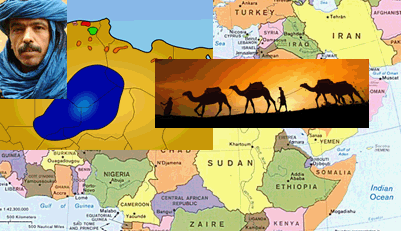
Why they thought the Berbers came from Yemen
by Lameen Souag, Jabal al-Lughat, June 23, 2010
A long-standing tradition in North Africa, convincingly rejected by Ibn Khaldūn but perpetuated by poets and curricula alike, claims that some major Berber tribes descend from Yemeni Arabs through semi-mythical pre-Islamic kings and their wholly mythical vast conquests. This idea has little to support it, and probably became popular because it allowed these tribes to claim prestigious connections in the context of a high culture dominated by Arab ideas; but why should the connection be specifically Yemeni, rather than, say, North Arabian or perhaps Persian? Linguistics suggests a possible answer.
In southern Arabia live several groups, most famously the Mehri tribe, whose languages, though Semitic, are only distantly related to Arabic, and quite incomprehensible to other Arabs. (You can hear recordings of it at SemArch.) Recently I borrowed a copy of the recently published Mehri Language of Oman, by Aaron Rubin; looking through it, I could see several points where Mehri resembles Berber but not Arabic that a traveller might seize on, notably:
• -s ـس “her”, -sÉ™n ـسن “their (f.)”; compare Siwi -nn-É™s ـنّس “his/her”, -n-sÉ™n ـنسن “their (m/f)”. A 3rd person in -s was found in proto-Semitic, as shown by Akkadian, but was replaced in Arabic.
• É™l ال “not” (preverbal first element of negative); compare Tumzabt ul Ø£ÙÙ„. Again, this is found in Akkadian and hence must be proto-Semitic.
• -ət ـت feminine singular; compare Siwi -ət ـت (feminine singular in Arabic borrowings.) Again, the connection is real, but dates back to proto-Semitic rather than indicating any special relationship between the two.
• -tən ـتن feminine plural; compare Berber -tən ـتن (plural of some masculine nouns)
• a- Ø£ÙŽ used as a definite article for some nouns; compare Berber a- Ø£ÙŽ(masculine singular noun prefix). A striking case is Mehri a-mÉ™sge:d أَمسجيد vs. Siwi a-mÉ™zdÉ™g أمزدج “the mosque”. However, in Mehri this indicates definiteness, and does not depend on gender; this is probably a coincidence.
• tÉ™-…-É™m تـ…ـم second person plural imperfective, eg tÉ™kÉ™ÌtbÉ™m تكتبم “you (pl.) write”; compare Berber t-…-m تـ…ـم. The t- is cognate; not sure about the history of the -m offhand.
• ‘Är آر “except, but”; compare Tuareg ar.
• Ä Ø¢ “oh” (vocative); compare pan-Berber a Ø£. (This is actually found in Classical Arabic as well, Ø£, but is not widely used.)
None of these similarities in fact imply any close relationship between Berber and Mehri, of course; some are coincidental, while others can be traced back to proto-Semitic, and hence constitute evidence connecting Berber with Semitic, not specifically with Mehri. However, a medieval traveller between Yemen and North Africa would not have known that, and could easily have observed similarities like these and leapt to the seemingly plausible conclusion that Berber was connected to the language of these Yemeni tribes, who, like many Berbers, seemed to live just like Arabs yet speak totally differently.